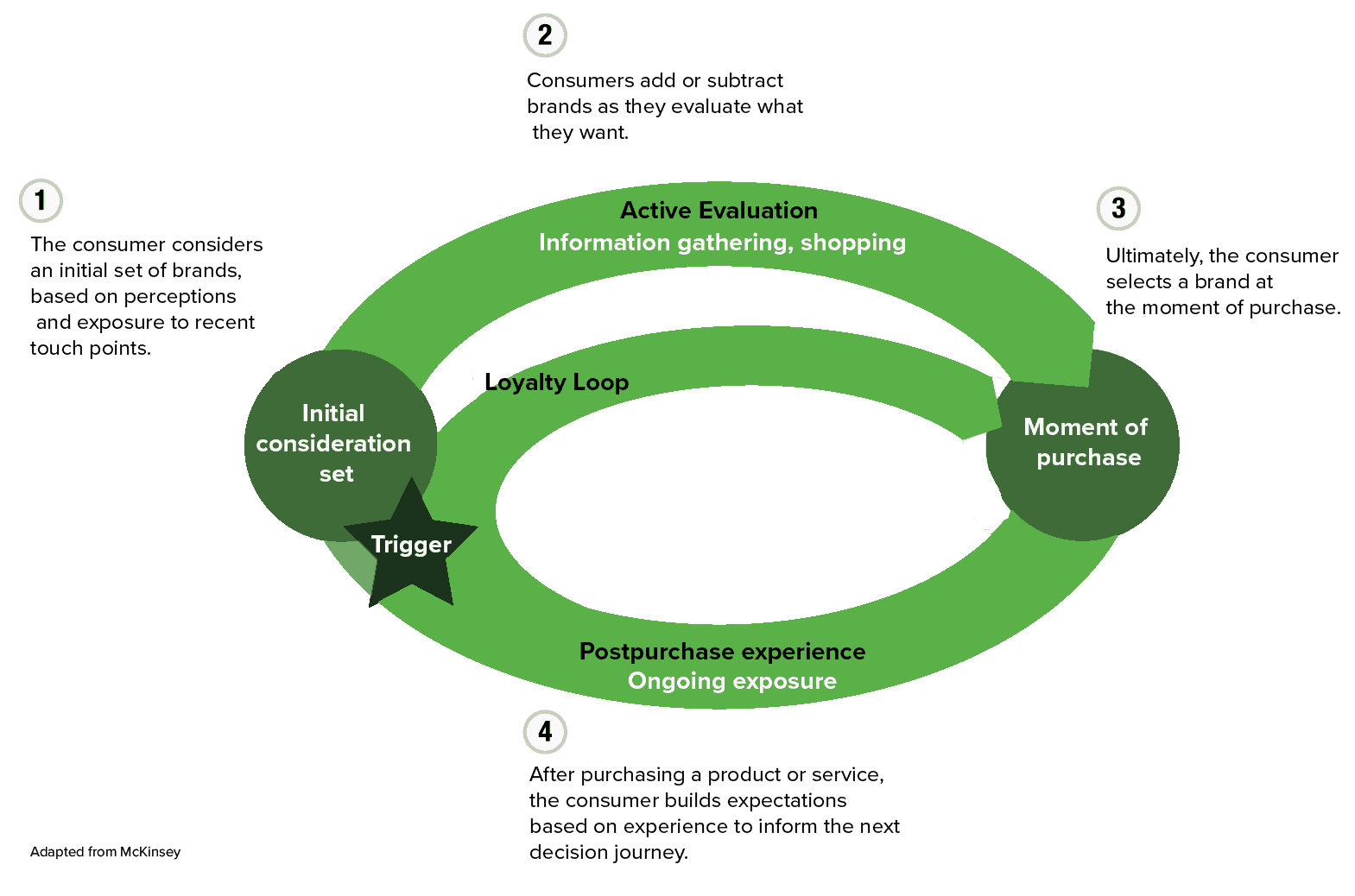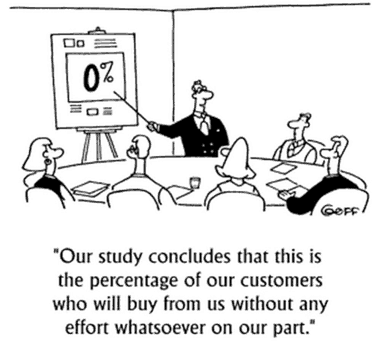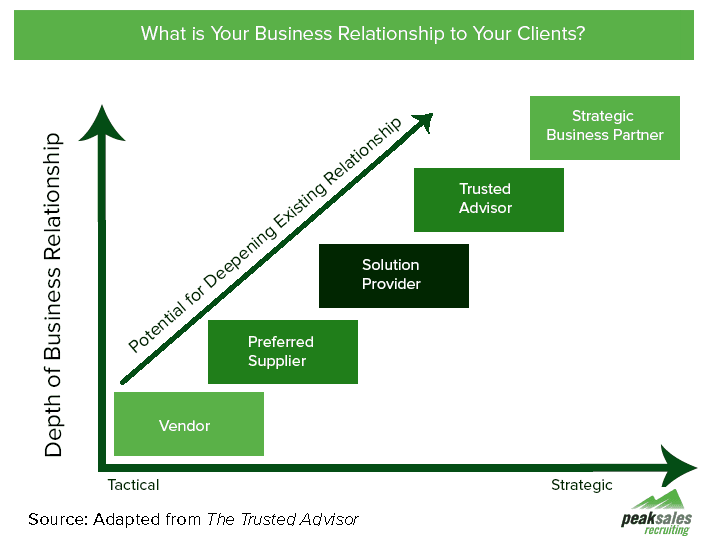
The world’s oldest professions is not immune to disruption. The evolving role of the sales rep, the maturation of millennials, the incorporation of big data and AI, and other ground-shaking variables are fundamentally impacting sales, forcing B2B sales leaders to brace for the shift.
Here are nine things you need to know about how B2B sales is changing:
1. Salespeople are still the most integral part of the B2B buying process — but the expectations have changed.

Seventy-percent of buyers want to involve a sales rep during the exploration stage. B2B buyers expect salespeople to help them work through complex buying challenges.
This contradicts Forrester’s study which suggests that salespeople are not as valuable as they used to be. Their overall value has not decreased. But their role is no longer to teach clients about the product, but to make it suit their situation.
B2B buyers don’t want an “off-the shelf” product. They want a comprehensive, customized solution that is tailored to meet their needs. Because of this, the sales rep of today is more important than ever.
Recent Gartner research shows that buyers no longer move through a funnel one step at a time. They needs sales people to guide them through the parallel processes of explore, evaluate, engage, and experience.

To reach clients, top B2B sellers are using the most influential activity: direct interaction to connect with buyers. This is buyer’s preferred method. Digital marketing channels, while still valuable, are some of the least influential marketing activities.

B2B buyers want to end their solo research by talking to a rep. That rep can take everything they’ve learned and package it into a personalized solution. Top reps of today embrace their changing role in the funnel by tailoring solutions for their clients.
2. Top reps are harnessing digital tools more than ever.

Top sales organizations invest in SEO. Since 93% of website traffic comes from a search engine and 50% of visitors are more likely to click on a link if it shows up more than once, SEO gives them an advantage over organizations that neglect to harness digital tools.
Traditional methods of product marketing are less effective than brand marketing. Fifty-four percent of buyers say they don’t trust traditionally branded content so marketers must shift their focus to brand awareness, using digital tools.
Brand awareness is extremely valuable since sixty percent of B2B buyers only shop with one or two brands in mind in the first place.
Wisely, 89% of marketers say brand awareness is their most important goal.
3. Big data is replacing “gut and feel”.
Companies that replace gut feeling with big data are 6% more profitable.
Big data allows competitive organisations to qualify leads by analyzing data and using it to create targeted content, eliminate unnecessary costs, and make better decisions by innovating products and processes.

Eighty-five percent of top organizations are moving in the direction of big data to radically improve lead generation, client relationship management, and maximize client value. Only 37% succeed.
Currently, there are over 6 million developers working on big data and advanced analytics. This number will not be decreasing. In fact, more big data has been produced in the past two years than in the history of humanity. Big data is not going away.
By 2020, there will be five times as many citizen data scientists as traditional data scientists.
4. AI is changing how we sell.
Seventy-two percent of business leaders think of AI as a “business advantage”. And yet, only 15% of businesses are using it.

Our reliance on AI can be quantified by the one billion voice searches per month. This has become a remarkable tool for businesses. Sales reps can now ask Alexa for insights into a prospective customer or ask Siri to bring up the numbers on last quarter.
AI disrupts the status quo. It pinpoints leads with the greatest likelihood of conversion. AI equips the modern sales rep with the tools they need to find their best-fit customers.
5. Millennials are forcing selling styles to change.
Today, there are 56 million millennials working which amounts to thirty percent of the workforce. Chances are, you work with at least one.
Millennials expectations with regards to marketing campaigns are for personalized, curated material. This does not change when they make purchasing decisions for their businesses.

Millennials make 73% of purchasing decisions for their companies. Top organizations attract millennial B2B buyers by focusing on personalized content, authentic relationships, efficiency, and corporate responsibility. They understand what their audience values.
Top sales organizations have adapted their processes to succeed among millennial buyers by concentrating on delivering efficiency, transparency, and uniting the buying team on a single solution.
6. Account-based selling is on the rise.
Buying teams today are comprised of 5.4 people rather than being the one-man-show they used to be. Top sales organizations know that it is ten times more expensive to gain new clients than maintain old one. They adapt to prioritize an account’s health.

Loyal customers are 60-70% more likely to buy again.
In addition, ABS allows smaller companies to successfully sell to micromarkets by focusing on “farming” to develop the client relationship.
ABS teams are now made if four primary roles: an account executive, a sales development representative, a marketer, and a support representative. ABS is responsible for 75% larger deals. Using the ABS system, companies have reported a 150% growth in customer lifetime value.
7. Hiring skilled reps is harder than ever.
The ease of posting online jobs blinds us to the recruiting crisis the sales industry faces.
Despite the increasing channels through which candidates can apply, top sales organization are not seeing candidate quality increase. Kevin Green, chairman of the Recruitment and Employment Confederation, said that the recent skill and talent shortages will only get worse and added:
“Organizations are going to have to work harder to attract talent over the next decade.”

To complicate matters, most top sellers are currently actively and gainfully employed. The good news is if you have invested in employer branding, you are three times more likely to make a quality hire. The bad news is top reps aren’t looking to be hired.
They are succeeding in their current role, adapting to the 20% longer B2B sales cycles, spending 33% more time with customers per week, focusing on 40% fewer accounts. This means that the top sellers are targeting their attention to nurturing fewer accounts while average sellers are inundating you with resumes.
Conclusion
Top organisations stay ahead of the curve when it comes to B2B sales. The changing roles of the sales rep, brand awareness, and big data are only the tip of the iceberg. AI, millennial buyers, account-based selling, and the shortage of talent will continue to flood the sales landscape and change the nature of B2B sales.
Like what you’ve read? Get your secret weapon in making your sales hiring process more effective by downloading our eBook, Make the Right Sales Hire, Every Time.
relpost-thumb-wrapper
Related posts
close relpost-thumb-wrapper
Eliot Burdett
He co-authored Sales Recruiting 2.0, How to Find Top Performing Sales People, Fast and provides regular insights on sales team management and hiring on the Peak Sales Recruiting Blog.
Latest posts by Eliot Burdett (see all)
- 20 Of Our Favorite Books About Sales Management and Sales Leadership – October 20, 2023
- How To Make Progress On Your Sales Goal Without A Sales Leader – September 15, 2021
- Augment Your Recruiting Strategy During “The Great Resignation” – July 26, 2021




